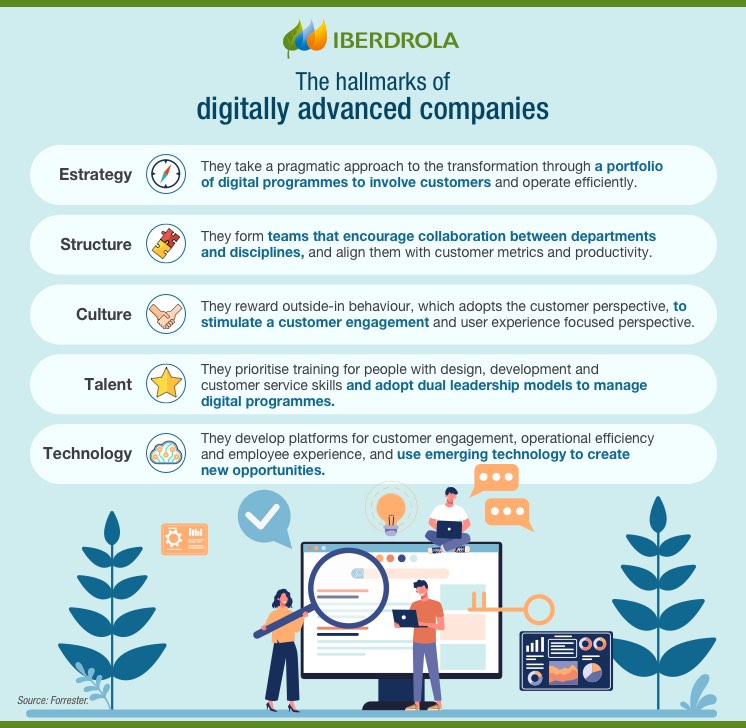DIGITAL MATURITY
Has your company conquered the challenge of digital transformation and achieved digital maturity?
The world's companies must invest in digital transformation if they want to survive in a world dominated by new technologies. How to calculate your level of digital maturity Companies that harness the technologies available to them to improve in areas including production, organisation or labour, are on the right track, but there are more aspects to take into account.

The digital revolution over the last two decades has changed everything from lifestyles and consumption patterns to labour skills, etc, while business models have developed at the same time. Companies around the world have been forced to embrace the digital transformation and to adapt so as not to be left by the wayside in this new era. However, how can you tell whether a company has reached digital maturity?
If the typical employee of a big company in the 1990s were to travel through time to the present day, they would immediately become a hopeless rookie due to their lack of digital skills. In just two decades, the technology revolution has left both companies and employees obsolete due to what has been called digital darwinism. So as not to be usurped by digital-native start-ups, companies are scrambling to invest in new technologies, hire digital profiles and retrain obsolete workers (reskilling and upskilling) multiplying their presence in new channels and listening to customers, among other initiatives, to absorb the new digital paradigm into their corporate cultures.
WHAT IS DIGITAL MATURITY
The term "digital maturity" refers to an organisation's degree of success in responding and adapting to disruptive technology. In other words, a company can be said to have achieved digital maturity when it has successfully adopted new technologies to optimise its results in all its business processes: internal operations, advertising campaigns, customer satisfaction, etc. Not forgetting that, because technological evolution never ends, companies can never afford to rest on their laurels.
The most significant technologies in the digital transformation include: artificial intelligence which, combined with machine learning can be used to create machines with similar capacities to humans; big data, which can analyse massive quantities of data and streamline business decisions; the internet of things (IoT) that connects objects to the web to improve their performance; and cloud computing, which gives remote access to software, data processing and file storage, etc. These and other products and services have been developed and they have spawned others such as: chatbots, artificial vision, predictive analysis, robotic process automation, business intelligence, blockchain, edge computing, and more.

SEE INFOGRAPHIC: The hallmarks of digitally advanced companies [PDF]
DIGITAL MATURITY MODELS
In the last decade, numerous digital maturity models and indexes have appeared to assess the level of digital transformation of companies and administrations. In the corporate world, the indicators for evaluating this question include: transformational leadership around a digital business model, the presence of the company in numerous channels (omnichannel strategy), data-driven decision-making and digital training for employees.
The following are among the main models used to measure digital maturity in companies:
- Digital Quotient (DQ) by McKinsey: is a metric presented in 2015 based on the findings of a study carried out in-house by the consultancy firm to understand the challenges of digitalisation. The firm analysed 150 companies around the world to assess their practices related to digital strategy, capacities and digital culture.
- Digital Maturity Model 4.0 by Forrester: is based on an earlier model. The consultancy firm created this tool in 2016 to classify companies into four maturity segments - sceptics, adopters, collaborators and differentiators - analysing their performance in four dimensions - culture, technology, organisation and perspectives—.
- MIT Maturity Model: in collaboration with Capgemini Consulting, the MIT Center for Digital Business developed this framework that combines two dimensions: Digital intensity, which measures investment in technological initiatives; and transformational intensity, which assesses leadership ability to digitally change an organisation.
DIGITAL MATURITY LEVELS
Each maturity model classifies companies at different levels based on the results of the assessment. In the case of the Digital Maturity Model 4.0 by Forrester, one of the most highly-thought-of, these are:
- Sceptics
They are at the start of the digital journey, in other words, they are technologically slow companies with little experience with innovation. They make insufficient use of online sales channels and launch few digital marketing programmes. - Adopters
These organisations are in the investment phase, both in infrastructure and knowledge, in other words, having realised that digitalisation works, they are willing to invest in the basic architecture needed to scale up their digital ambitions. - Collaborators
Their main hallmark is their willingness to collaborate internally and externally to allow practice and digital innovation. In this segment, there is more coordination and communication among IT and marketing departments. - Differentiators
With better skills in digital marketing and e-commerce, including project management and customer knowledge, they report strong growth in returns and tend to be retailers focused on online business.
HOW TO MEASURE DIGITAL MATURITY
Techno giant Google, in collaboration with Boston Consulting Group (BCG), has developed a Digital Maturity Benchmark with which to measure the digital maturity of a brand. In a report entitled The Fast Track to Digital Marketing Maturity, the companies identified six factors that enable companies to advance along the maturity curve:
| Data
Linking the company's data sources to obtain a customer overview.| Automation
Have tools, like web analytics or CRM, which can be used to automate data.| Measurement
Measure the value of each contact point throughout the customer journey and link them to results.| Strategic associations
Collaborate with agencies and technology suppliers retaining ownership of the data.| Specific skills
Assigning people with complementary skills in efficient multifunctional teams.| Streamlined teamwork
Internal processes must be agile, which requires leadership and active cooperation.




